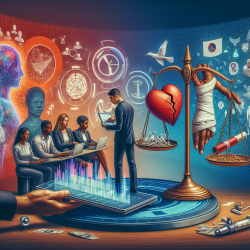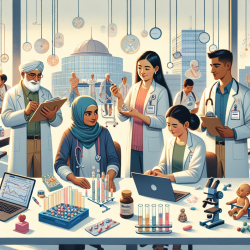Introduction
The landscape of healthcare is rapidly evolving, with digital health technologies at the forefront of this transformation. A recent study, "Sociotechnical imaginaries in academic medicine strategic planning: a document analysis," explores how academic medicine is preparing for this digital future. This blog post will delve into the key findings of the study and discuss how practitioners can harness these insights to improve their skills and outcomes.
Understanding Sociotechnical Imaginaries
The concept of sociotechnical imaginaries refers to the collective visions of desirable futures shaped by advancements in science and technology. In the context of academic medicine, these imaginaries frame how digital health technologies are perceived and integrated into strategic planning. The study analyzed 59 strategic plans from Canadian medical schools and health science centers, revealing two primary imaginaries: continuation and transformation.
Continuations: Expanding Existing Practices
Some strategic plans view digital health as an extension of current practices, enhancing physician competencies and research capabilities without disrupting existing power structures. For instance, medical schools emphasize the role of technology in augmenting educational practices and preparing graduates for future challenges. This approach focuses on leveraging digital tools to improve existing processes, such as virtual reality in education and advanced communication platforms.
Transformations: Shaping a New Healthcare Landscape
Conversely, other plans envision a transformative impact of digital health on healthcare delivery and knowledge distribution. Academic health science centers (AHSCs) highlight the potential of technologies like AI and data analytics to revolutionize patient care and organizational operations. These imaginaries suggest a future where healthcare is more personalized, efficient, and data-driven, with patients playing a more active role in their care.
Implications for Practitioners
Practitioners can benefit from understanding these sociotechnical imaginaries by:
- Embracing technology: Stay informed about emerging digital tools and consider how they can enhance your practice.
- Fostering collaboration: Work with interdisciplinary teams, including data scientists and engineers, to integrate digital solutions effectively.
- Adapting to change: Be open to new models of care and patient engagement, recognizing the potential for digital health to reshape traditional roles.
Encouraging Further Research
The study underscores the importance of ongoing research to navigate the complexities of digital health integration. Practitioners are encouraged to engage with social science literature on digital health and collaborate with researchers to explore the implications of these transformations. By doing so, they can contribute to a more nuanced understanding of how digital health can be harnessed to improve patient outcomes and healthcare delivery.
Conclusion
As the healthcare landscape continues to evolve, understanding the sociotechnical imaginaries shaping academic medicine is crucial for practitioners. By embracing digital health technologies and engaging in interdisciplinary collaboration, practitioners can position themselves at the forefront of this transformation, ultimately improving outcomes for their patients.
To read the original research paper, please follow this link: Sociotechnical imaginaries in academic medicine strategic planning: a document analysis.










